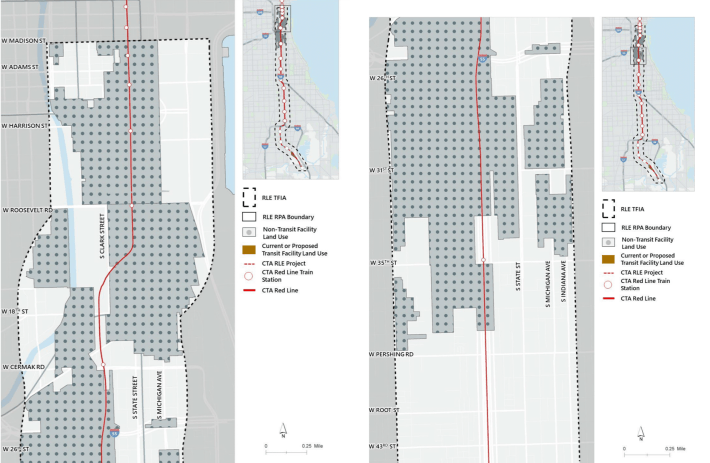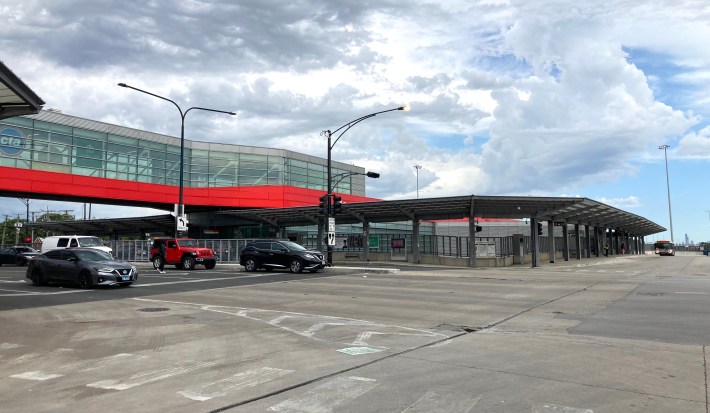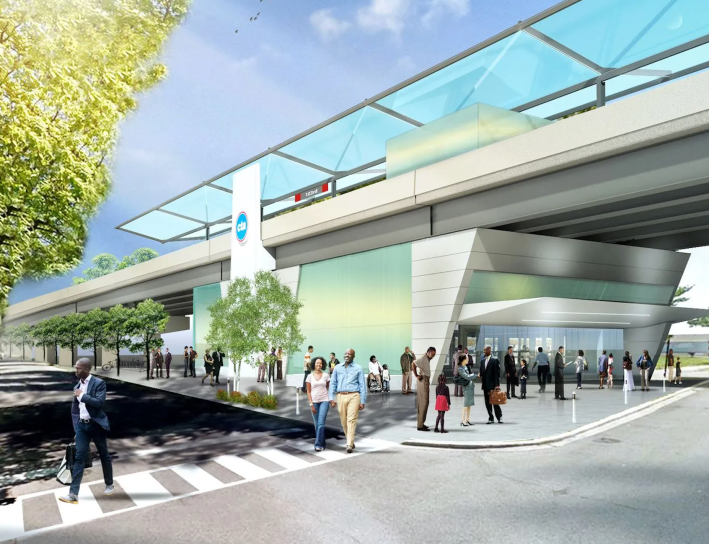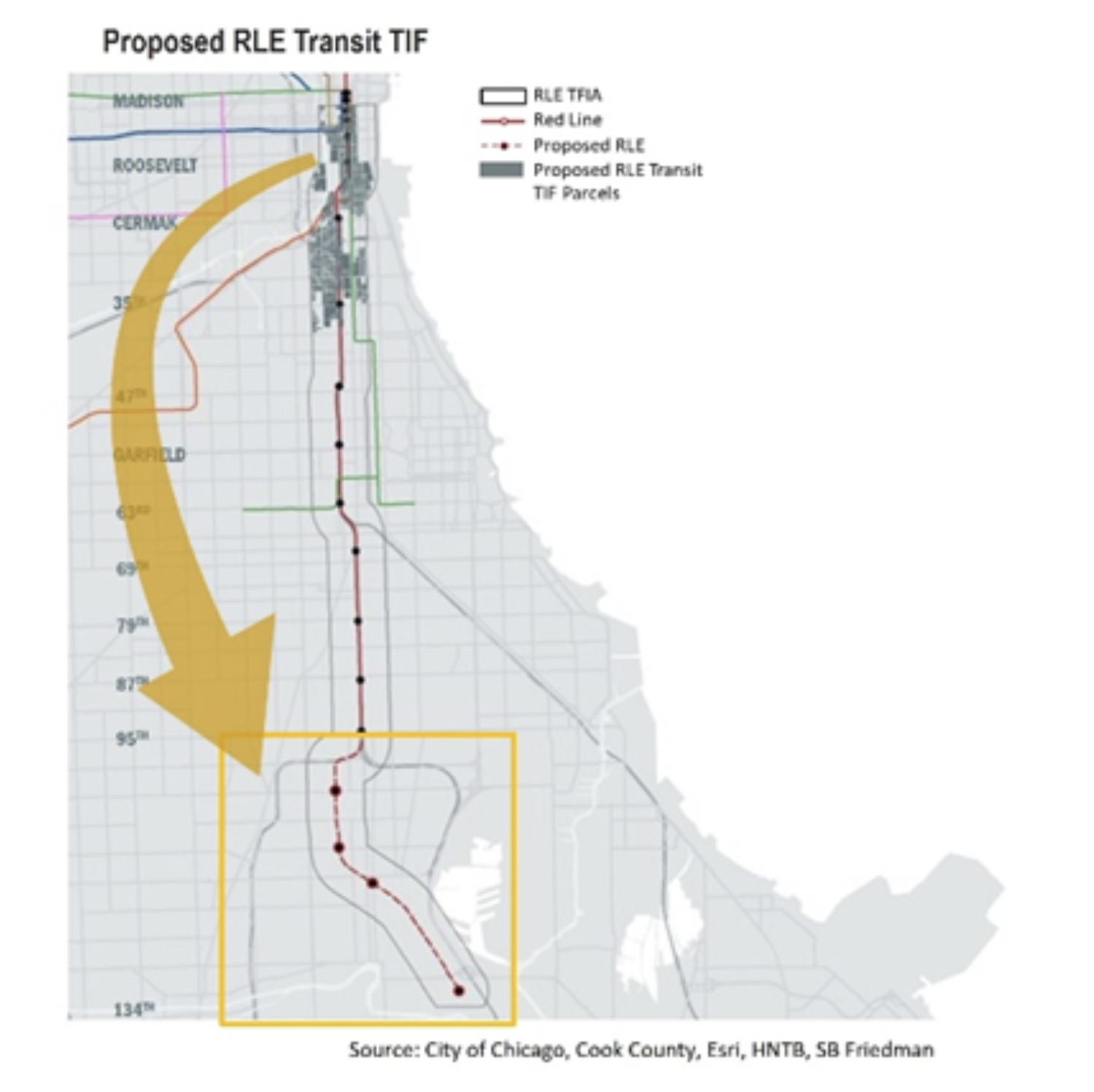As the projected price tag for the long-awaited Red Line extension on the Far South Side increased by $1.3 billion dollars to $3.6 billion, the city of Chicago is looking to establish a new Transit TIF district to finance about a quarter of the cost. However, that plan is proving controversial, for reasons I'll discuss below.
A Transit TIF works similarly to any other Tax Increment Financing district, in that the amount of property tax revenue the city and other taxing bodies get from the zone is frozen, and any additional property tax money generated in the future is deposited in a TIF fund. The key difference with a Transit TIF is that, as the name suggests, it’s used specifically for transit projects, and it's designed to not divert any funding from public schools. The city previously established a Transit TIF district to fund the CTA's Red and Purple Modernization program. That district is a zone several blocks wide along the Red Line tracks between North and Devon avenues.

The controversial aspect of the proposed South Side Transit TIF is that it would collect revenue from land parcels located several miles north of the Red Line Extension project area in order to fund that initiative. The zone would include parts of the Loop, the South Loop, Chinatown, Bridgeport, Fuller Park and Bronzeville. The TIF is projected to generate up to $950 million, with the rest of the project funding coming from federal sources and bond sales.
The proposed Transit TIF is still in the early stages of approval. But during a discussion at the August 9 meeting of the city's Community Development Commission, the first step of the process to approve the district, South Side alderpersons Pat Dowell (3rd) and Anthony Beale (9th) expressed opposition. The commission members also voiced concerns that they didn’t have adequate time to review the proposal.
Red Line Extension Costs
The current Red Line Extension timeline calls for construction to start in 2025. While the CTA previously estimated the cost at $2.3 billion, the agency said in a statement to Steetsblog that the new price tag increase reflects a better understanding of the project specifics. “The cost was also updated to account for the actual year of expenditure, based on an updated schedule from 2020, as well as incorporating additional costs related to inflation, which is particularly impacting construction labor and materials right now,” it stated. “CTA is confident in this updated $3.6 billion project cost estimate, and we have an excellent record for completing its capital projects on-time and on-budget.”
The CTA is applying for a $2.16 billion Federal Transit Administration’s New Starts transit capital investment grant. It would require a local match, which could be anywhere from 20 percent to 50 percent. The South Side Transit TIF is expected to generate around 30 percent of the cost. The rest of the funding will come from $30 million Congestion Mitigation and Air Quality Improvement (CMAQ) grant, and proceeds from bond sales.
The CTA argued that what it is proposing with the South Side Transit TIF wouldn’t be much different from North Side Transit TIF. That TIF was projected to generate $622 million, covering about 30 percent of the RPM Phase I project cost. The agency also noted that the North Side TIF extended far beyond the project area. But unlike the proposed South Side Transit TIF, the North Side zone at least included the entire project area. The transit agency has argued that, although the RLE is only taking place on the Far South Side, it will have benefits for all Chicagoans, including providing more residents with good transit access to education, jobs, and other resources.
Other proponents might argue that, by using funding from wealthier parts of town to help pay for a project to help residents in under-resourced areas, the South Side Transit TIF will have something of a Robin Hood effect.

Discussing the Issue
The Community Development Commission tends to fly under the radar, but it plays an important role in city funding decisions. One of its duties is reviewing proposed TIFs. During the August 19 meeting, the Department of Planning and Development asked the commission for permission to release the preliminary Transit TIF study and schedule a public hearing.
Lou Turner, a professor of urban and regional planning at the University of Illinois Urbana-Champaign, spoke in support of the Transit TIF, saying that it was long overdue, especially since the North Side got a Transit TIF first. “[The Red Line extension] is the largest infrastructure project being proposed in any Black community in this country, and I think it would be really a shame to miss the opportunity where everything is aligning in terms of funding and planning, to actually realize this major project for the Far South Side of Chicago, the area that, as you know, is a transportation desert,” he said.
Ald. Dowell, whose ward includes much of South Loop, Bronzeville and Washington Park, said that while the extension was “important and necessary to help provide more equitable transportation options” for Far South Siders, the transit TIF “will take my constituents' property tax obligations and apply them miles away.”
“That proposed use of funds does not align with the purpose of the TIF and creates a burden on [my constituents] without any direct benefit,” Dowell added. “I'm also concerned about the potential precedent being set that will allow geographically unconnected projects to be funded just [by] simply raiding well-capitalized TIFs.”
Counterintuitively Ald. Beale, whose Far South Side Ward would directly benefit from the Red Line Extension, since it includes about half of the planned route, said he also opposes the Transit TIF. “As much as I would love to have [Dowell’s] constituents' money come to the Far South Side, I just think that this is a bad precedent and a bad use of TIF [funding], and I think it is very shortsighted that we're looking for a shortcut."
Beale also argued that, by agreeing to pay a fourth of the cost, the city was "letting the federal government off the hook... From Day One, we said that the federal government and the state of Illinois would fund the Red Line Extension. Now, sometimes I do understand that the city has to put some skin in the game, but this is more than a skin. This is an arm and a leg that the City of Chicago is looking to put in for this particular project.”
To put Beale's statement in perspective, only about half of the $2.1 billion RPM Phase I cost was funded by the feds.

The Community Development Commission voted in favor of releasing the draft and scheduling the public hearing, but only after striking the word “ratify” from the resolution. The commission only received the draft on August 5, and several commissioners said they weren’t comfortable ratifying something they didn’t have a chance to review. They only agreed to move forward after getting assurances from DPD and CTA that they will still vote on the final draft after the public haring is held.
The feasibility study and the draft redevelopment plan have since been posted on the city's website.
The public hearing on the TIF is expected to be held in October. The city must also hold the Joint Review Board meeting, which will include representatives of all affected taxing bodies. After the final draft clears the Community Development Commission, it will need to clear the Chicago Plan Commission before going to the city council for final approval.
The Metropolitan Planning Council declined to comment on either the increased costs or whether the proposed Transit TIF makes sense.
The Active Transportation Alliance declined to comment on the Transit TIF as well, but ATA advocacy manager Julia Gerasimenko said the increased price tag shouldn’t deter the city from funding the project. “The economic and social impact this project will have is significant, and merits the investment after decades of promises for Far South Side communities. Now is the time to take advantage of unprecedented levels of federal funding to push this project forward as soon as possible. Compared to what has been invested in other parts of the city, the Far South Side is overdue for an investment that will improve the quality of life for residents along the corridor.”




